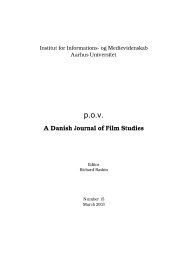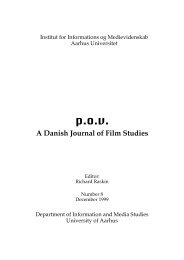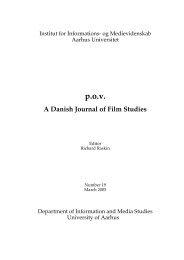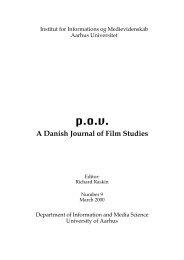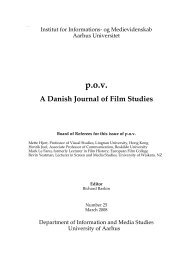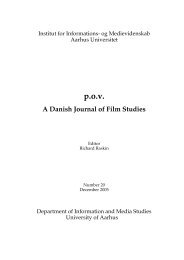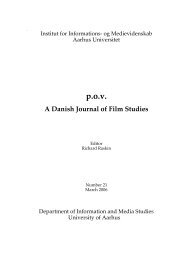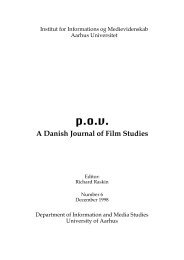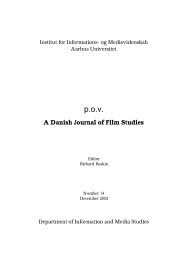The Face of Time - POV - Aarhus Universitet
The Face of Time - POV - Aarhus Universitet
The Face of Time - POV - Aarhus Universitet
You also want an ePaper? Increase the reach of your titles
YUMPU automatically turns print PDFs into web optimized ePapers that Google loves.
A Danish Journal <strong>of</strong> Film Studies 25<br />
their focus on their own bodies, combing their hair, letting the water<br />
flow over their bodies, and watching themselves in the mirrors. <strong>The</strong><br />
grown women continue to watch themselves in the mirrors, drink<br />
the water, eat, smoke, bathe, and massage each other. <strong>The</strong> older<br />
women are characterized by no longer being in physical contact<br />
with anyone. Instead <strong>of</strong> acting on their own, they increasingly come<br />
to occupy an observing role.<br />
Thus, different characteristics and patterns <strong>of</strong> action are connected<br />
to different ages, and the sensual perception <strong>of</strong> the world is used to<br />
describe this development. At this level each shot comes to<br />
represent time, with each transition adding years to the bodies.<br />
This representation <strong>of</strong> time and thus <strong>of</strong> continuity in the film is<br />
also expressed in its visual style. <strong>The</strong> transitions between the shots<br />
are all fast dissolves and continuity between the shots is created in<br />
different ways. Sometimes it’s the movement <strong>of</strong> the camera, leading<br />
from one shot into the next. At other times, it's a movement within<br />
pictures that resemble one another, and are brought together by<br />
dissolves, making the visual structure the dominant principle for the<br />
transitions. This creates a visual flow in the film that parallels the<br />
time perspective, while the representation <strong>of</strong> the bodies that become<br />
progressively older creates a narrative flow. <strong>The</strong> film’s use <strong>of</strong> music<br />
and the sound <strong>of</strong> water as a recurring and connecting element is<br />
another means by which continuity is strengthened.<br />
Experience<br />
Whereas the previous narrative level deals with the material and<br />
physiological – the body, the senses and the natural – there is also a<br />
level in the film that deals with the social, the psychological and the<br />
cultural. This manifests itself in the way the bodies act and interact



